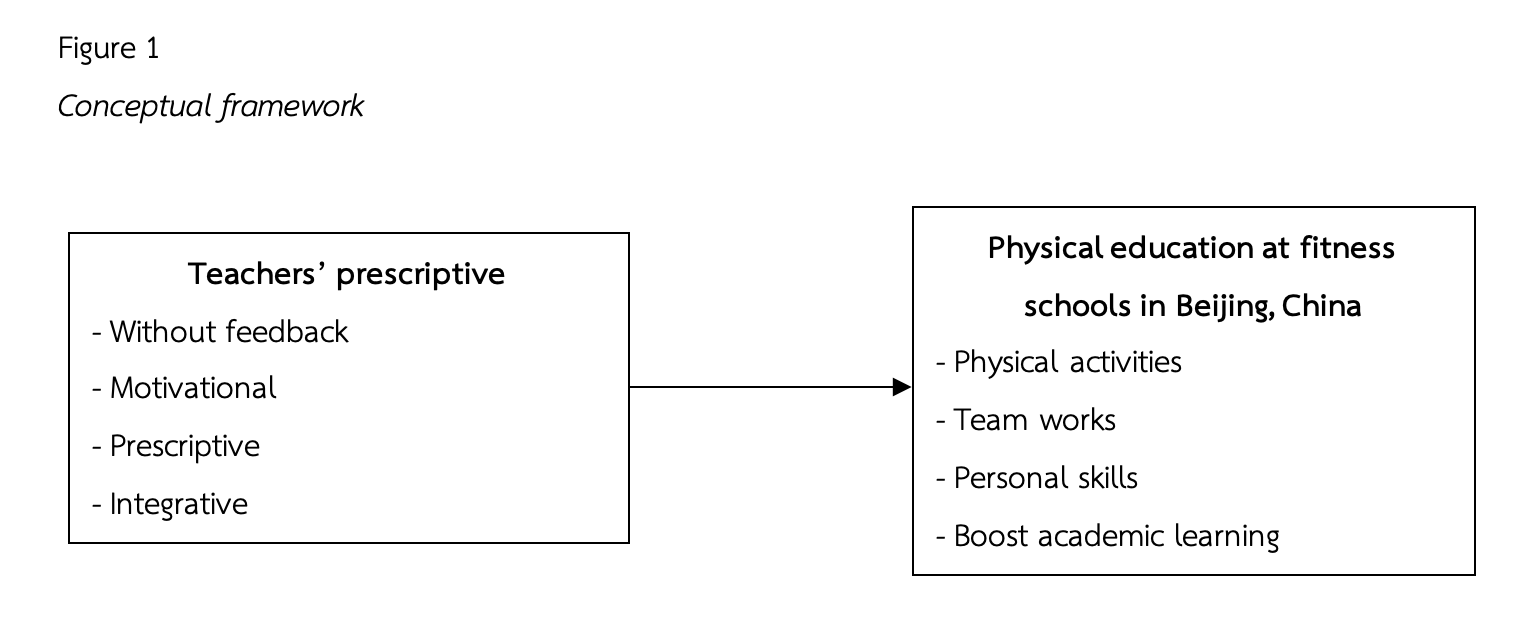THE EFFECT OF TEACHERS’ PRESCRIPTIVE TO PHYSICAL EDUCATION AT FITNESS SCHOOLS IN BEIJING, CHINA
Main Article Content
บทคัดย่อ
The purpose of this research was to study level of teachers' prescriptive and physical education at Fitness Schools in Beijing, China. And To study relationship between teachers' prescriptive and physical education at Fitness Schools in Beijing, China. The sample used was 50 teachers. People at Fitness Schools in Beijing, China used questionnaires to collect data. Through convenience sampling, the data was analyzed by frequency, percentage, mean and standard deviation. and test the hypothesis with Pearson correlation.
The results showed that Most of the respondents were female, aged 31-40 years, with a higher education level. They have an average monthly income of 6,001-8,000 yuan. Respondents' opinions on Teachers' prescriptive and Physical education at Fitness Schools in Beijing, China overall are high. The hypothesis testing found that teachers' prescriptive had a statistically significant relationship with physical education at Fitness Schools in Beijing, China for 2 pairs, including without feedback, positively correlated with physical activities. The statistic at the .000 level was moderately correlated, and the Integrative was positively correlated with the physical activities at the .000 level, which was moderately correlated.
Article Details
เอกสารอ้างอิง
Bailey, R. (2006). Physical Education and Sport in Schools: A review of benefits and outcomes. Journal of School Health, 76(8), 397-401.
Bulger, S. M., Mohr, D. J., Carson, L. M., & Wiegand, R. L. (2004). Curricular issues in physical education teacher education. Journal of Physical Education, Recreation & Dance, 75(8), 47-55.
Corbin, C. B. (2021). Conceptual physical education: A course for the future. Journal of Sport and Health Science, 10(3), 308-322.
Cothran, D. J. & Kulinna, P. H. (2008). Teachers’ knowledge about and use of teaching models. Physical Educator, 65(3), 122-133.
Couturier, L. E., Chepko, S., & Coughlin, M. A. (2007). Whose gym is it? Gendered perspectives on middle and secondary school physical education. The Physical Educator, 64(3), 152-159.
Halpin, B. (2012). The National Association for Sport and Physical Education (NASPE) urgently needs your help!. PALAESTRA, 26(1), 38-38.
Ivanova, N. L., & Korostelev, A. A. (2019). The impact of competitive approach on students’ motivation in sport. Amazonia investiga, 8(18), 483-490.
Kinchin, G. D., & O’Sullivan, M. (2003). Incidences of student support for and resistance to a curricular innovation in high school physical education. Journal of teaching in physical education, 22(3), 245-260.
Lambert, K. (2020). Re-conceptualizing embodied pedagogies in physical education by creating pre-text vignettes to trigger pleasure ‘in’movement. Physical Education and Sport Pedagogy, 25(2), 154-173.
Martin, J. J., McCaughtry, N., Kulinna, P. H., & Cothran, D. (2009). The impact of a social cognitive theory‐based intervention on physical education teacher self‐efficacy. Professional development in education, 35(4), 511-529.
Mohr, D. J., Townsend, J. S., & Pritchard, T. (2006). Rethinking middle school physical education: Combining lifetime leisure activities and sport education to encourage physical activity. Physical educator, 63(1), 18.
Mood, D. P., Jackson, A. W., & Morrow Jr, J. R. (2007). Measurement of physical fitness and physical activity: Fifty years of change. Measurement in Physical Education and Exercise Science, 11(4), 217-227.
Nates, J. L., Nunnally, M., Kleinpell, R., Blosser, S., Goldner, J., Birriel, B., ... & Sprung, C. L. (2016). ICU admission, discharge, and triage guidelines: a framework to enhance clinical operations, development of institutional policies, and further research. Critical care medicine, 44(8), 1553-1602.
Oh, J., & Graber, K. C. (2019). Physical education teacher education leaders’ perceptions on a national curriculum in physical education. Research quarterly for exercise and sport, 90(3), 362-376.
Rikard, G. L., & Banville, D. (2006). High school student attitudes about physical education. Sport Education and Society, 11(4), 385-400.
Ryan, S., Fleming, D., & Maina, M. (2003). Attitudes of middle school students toward their physical education teachers and classes. Physical Educator, 60(2), 28.
Ward, P. (2020). Core practices for teaching physical education: Recommendations for teacher education. Journal of Teaching in Physical Education, 40(1), 98-108.
Whittle, R., & MacPhail, A. (2020). The PE school curriculum challenge: The shared construction, implementation and enactment of school physical education curriculum. In School physical education and teacher education (pp. 103-115). Routledge.
Woods, M. L., Goc Karp, G., Miao, H., & Perlman, D. (2008). Physical educators' technology competencies and usage. Physical Educator, 65(2), 82-99.


